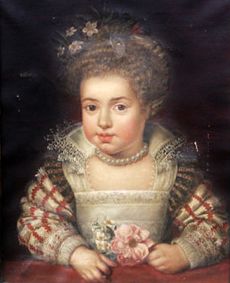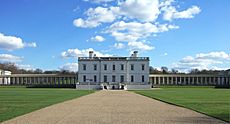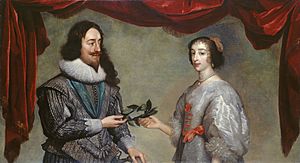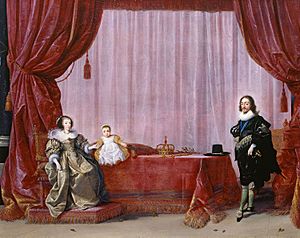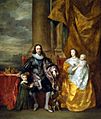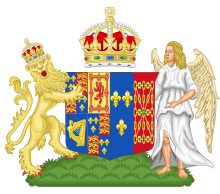Henrietta Maria facts for kids
Quick facts for kids Henrietta Maria |
|
|---|---|

Portrait by Anthony van Dyck
|
|
| Queen consort of England, Scotland and Ireland | |
| Tenure | 13 June 1625 – 30 January 1649 |
| Born | 25 November 1609 Palais du Louvre, Paris, Kingdom of France |
| Died | 10 September 1669 (aged 59) Château de Colombes, Colombes, Kingdom of France |
| Burial | 13 September 1669 Royal Basilica of Saint Denis |
| Spouse | |
| Issue more... |
|
| House | Bourbon |
| Father | Henry IV of France |
| Mother | Marie de' Medici |
| Religion | Roman Catholicism |
| Signature | |
Henrietta Maria (French: Henriette Marie; 25 November 1609 – 10 September 1669) was the Queen of England, Scotland, and Ireland. She became queen when she married King Charles I on 13 June 1625. She remained queen until Charles was executed on 30 January 1649. She was the mother of two future kings, Charles II and James II. Her husband wanted her to be known as 'Queen Mary' in England, but she preferred "Henriette R" or "Henriette Marie R". The "R" stands for regina, which is Latin for "queen."
Henrietta Maria was a Roman Catholic. This made her unpopular in England, where the official church was the Church of England. Because of her religion, she could not be crowned in a Church of England ceremony. So, she never had a coronation. As the civil war grew closer, she became more involved in national matters. In 1644, after her youngest daughter, Henrietta, was born during the war, she had to escape to France. After Charles I was executed in 1649, she became very poor. She lived in Paris and returned to England when her son, Charles II, became king again in the Restoration. In 1665, she moved back to Paris and died there four years later.
The North American Province of Maryland was named after Queen Henrietta Maria. This area was a safe place for Roman Catholic settlers. Today, it is known as the U.S. state of Maryland.
Contents
Early Life
Henrietta Maria was the youngest daughter of Henry IV of France and his second wife, Marie de' Medici. She was born at the Palais du Louvre in Paris on 25 November 1609. Some historians say she was born on 26 November. In England, where a different calendar was used, her birth date was often recorded as 16 November.
She was raised as a Roman Catholic. As a daughter of the French king, she was called a Fille de France and belonged to the House of Bourbon. She was the youngest sister of the future Louis XIII of France. Her father was killed on 14 May 1610, when she was less than a year old. As a child, she was looked after by the royal governess Françoise de Montglat.
Henrietta Maria and her sisters learned riding, dancing, and singing. They also took part in plays at court. She was taught to read and write, but she was not known for being very academic. Her religious training was greatly influenced by the Carmelites at the French court. By 1622, Henrietta Maria lived in Paris with about 200 staff members. Plans for her marriage were already being discussed.
Marriage Discussions
Henrietta Maria first met her future husband, Charles, in 1623. This happened at a court event in Paris. At the time, Charles was on his way to Spain with the Duke of Buckingham. They were going to discuss a possible marriage for Charles with Maria Anna of Spain.
However, that marriage plan did not work out. The King of Spain wanted Charles to become Catholic and live in Spain for a year. Charles found these terms unacceptable. When he returned to England, he and Buckingham asked King James, Charles's father, to declare war on Spain.
Charles then looked for another bride. In 1624, he sent his close friend Henry Rich, 1st Earl of Holland, to Paris. Holland liked France and strongly supported a marriage with Henrietta Maria. The terms of their marriage were worked out by James Hay, 1st Earl of Carlisle.
Becoming Queen
A proxy marriage was held at Notre-Dame de Paris on 1 May 1625. In this ceremony, Duke Claude of Chevreuse stood in for Charles. This happened shortly after Charles became king.
Because Henrietta Maria was Roman Catholic, she could not take part in the Church of England ceremony. This was when Charles was crowned king in Westminster Abbey on 2 February 1626. It was suggested that she be crowned by the bishop who came with her to England. But this was not allowed. She was only permitted to watch her husband's coronation from a distance. This made the people of London unhappy. England's friendly policy towards France also changed quickly.
After a difficult start, Henrietta Maria and Charles became very close. They were devoted to each other. However, Henrietta Maria never fully fit into English society. She did not speak English before her marriage. Even in the 1640s, she found it hard to write or speak the language. This, along with her Catholicism, made her unpopular. Many English people feared "Papist" (Catholic) plots, like the Gunpowder Plot.
Some people have said Henrietta Maria was "unpolitical, uneducated, and silly" in the 1630s. Others believe she had some power through her strong faith, her charm, and her support for the arts.
Her Catholic Faith and Home Life
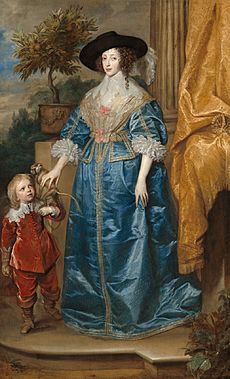
Henrietta Maria was a very religious Roman Catholic. Her faith greatly influenced her time as queen, especially in the early years of her marriage. In July 1626, she caused a big stir. She stopped at Tyburn to pray for Catholics who had been executed there. Later, she tried to convert her nephew, Prince Rupert, who was a Protestant.
At first, people were unsure what to call the new Queen. King Charles decided she would be known publicly as "Queen Mary." He himself liked to call her "Maria." By using the name Queen Mary, the English people might also have thought of Charles's grandmother, Mary, Queen of Scots.
Henrietta Maria was open about her beliefs. She tried to stop plans that would force the eldest sons of Catholic families to be raised as Protestants. She also helped arrange Catholic marriages, which was against English law at the time.
The new queen brought many expensive things with her. These included jewelry, fancy clothes, and valuable items for her home. She also came with a large and costly group of staff. This included her ladies-in-waiting, twelve priests, and her pages. Charles blamed these advisors, especially her main friend Madame St. George, for the bad start to his marriage.
On 26 June 1626, Charles ordered them to leave. This upset Henrietta Maria greatly. Some staff refused to go, saying they had orders from the French king. In the end, they were forced out. But she managed to keep her chaplain and confessor, Robert Phillip. She also kept seven of her French staff, including her nurse and dresser.
Removing her staff was part of a plan to control her huge spending. Her debts were still being paid off years later. Charles appointed Jean Caille as her treasurer. Despite these changes, her spending remained high. In 1627, she was secretly borrowing money. Her records show she bought many expensive dresses before the war.
People worried about her health. In July 1627, she went with her doctor to take medicinal waters in Northamptonshire. Charles visited her nearby.
Over the next few years, the Queen's new household grew around her. Henry Jermyn became her favorite and a key helper in 1628. The Countess of Denbigh became her Head of Robes and a close friend. She also had several court dwarves, like Jeffrey Hudson. By 1630, Henrietta Maria had homes at Somerset House, Greenwich Palace, and other places. Charles bought her Wimbledon House in 1639 as a gift. She also had many pets, including dogs, monkeys, and birds.
Her Relationship with Charles
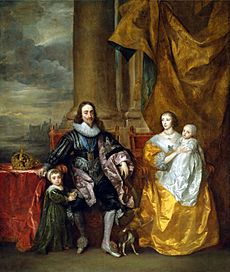
Henrietta Maria's marriage to Charles did not start well. His removal of her French staff made things worse. At first, their relationship was cold and full of arguments. Henrietta Maria immediately disliked the Duke of Buckingham, who was the King's favorite.
One of Henrietta Maria's closest friends early in her marriage was Lucy Hay. Lucy was a strong Protestant, very beautiful, and had a powerful personality. Some believe Lucy tried to control the new queen for Buckingham. However, by the summer of 1628, they were very close friends.
In August 1628, Buckingham was killed. This left a gap in the royal court. Henrietta Maria's relationship with her husband quickly began to get better. They formed a deep bond of love and affection. Henrietta Maria often played jokes on Charles.
Henrietta Maria became pregnant for the first time in 1628. But she lost her first child shortly after birth in 1629, after a very difficult delivery. In 1630, their son, the future Charles II, was born successfully. By this time, Henrietta Maria had become Charles's closest friend and advisor.
Even though the French staff were sent away in 1626, Charles's court was still very French in style. French was often used instead of English, as it was seen as more polite. Charles often wrote letters to Henrietta Maria, calling her "Dear Heart." These letters show how loving their relationship was. For example, on 11 January 1645, Charles wrote that he would risk any danger to be with her.
As her relationship with her husband grew stronger, Henrietta Maria stopped being close friends with Lucy Hay in 1634. The exact reasons are not clear. But Lucy was a strong Protestant and lived a more wild life than the Queen. Henrietta Maria might also have felt overshadowed by Lucy. Since she now had such a close bond with Charles, she did not need other close friends as much.
Supporting the Arts
Henrietta Maria loved the arts. Her support for different artists and activities was one way she influenced court life. She and Charles were "dedicated and knowledgeable collectors" of paintings. Henrietta Maria was especially known for supporting the Italian painter Orazio Gentileschi. He came to England in 1626. Orazio and his daughter Artemisia Gentileschi painted the huge ceilings of the Queen's House at Greenwich. The Italian artist Guido Reni was another favorite, along with miniature painters.
Henrietta Maria became a key supporter of court plays called masques. She performed in some of these herself. She also supported the English composer Nicholas Lanier. She was responsible for William Davenant becoming the Poet Laureate in 1638.
The queen also liked sculptures and designs. She kept the designer Inigo Jones as her surveyor of works in the 1630s. Like Charles, she loved garden design. She hired André Mollet to create a baroque garden at Wimbledon House. She supported the French sculptor Hubert Le Sueur. Her private chapel looked plain on the outside. But inside, it had gold and silver religious items, paintings, statues, a chapel garden, and a beautiful altarpiece by Rubens.
The English Civil War
In the 1640s, England, Scotland, and Ireland were involved in conflicts called the English Civil War. In England, the fight was between the Royalists (who supported the King) and the Parliamentarians (who supported Parliament). Queen Henrietta Maria became deeply involved in this war. It led to her husband's death and her exile in France.
Some historians believe Henrietta Maria had a big role in the Royalist defeat. They say she was a strong-willed woman who controlled her husband too much. Others argue that her political role was smaller. A more recent idea is that she did have political power. This was not always direct, but through her public actions, which influenced Charles's choices.
Before the War
By the late 1630s, tensions between English groups were very high. Arguments over religion, society, and political power became clear before the war began. Henrietta Maria's strong religious views and her court's social life meant that by 1642, she was "highly unpopular." Most of her subjects did not respect or feel loyal to her.
Henrietta Maria remained sympathetic to other Catholics. In 1632, she started building a new Catholic chapel at Somerset House. The old chapel had been very unpopular with Protestants. Many London apprentices had talked about tearing it down. Henrietta Maria's new chapel was modest outside but very fancy inside. It opened with a grand ceremony in 1636. This caused great worry among many Protestants.
Henrietta Maria's religious activities seemed to focus on bringing a modern form of Catholicism to England. To some extent, it worked. Many people in her circle converted to Catholicism. Historians believe there may have been up to 300,000 Catholics in England by the late 1630s. They were certainly more open in court society. Charles was criticized for not stopping these high-profile conversions. Henrietta Maria even held a special mass in her private chapel when a Jesuit priest died in 1638. She also continued to act in plays called Masques throughout the 1630s. This was criticized by the more Puritan part of English society. In these plays, she often chose roles that promoted unity among Christians and Catholic ideas.
This led to growing dislike for Henrietta Maria in Protestant English society. It gradually turned into hatred. London society blamed Henrietta Maria for the Irish Rebellion of 1641. They believed it was planned by Jesuits, whom she was linked to in the public mind. Henrietta Maria herself was rarely seen in London. She and Charles had mostly stayed away from public life in the 1630s. This was partly for privacy and partly because court events were expensive.
By 1641, a group of Parliamentarians led by John Pym began to pressure Charles. Charles was already struggling after losing several wars. Parliament arrested and later executed the king's advisors, Archbishop William Laud and Thomas Wentworth, Earl of Strafford. Pym then focused on Henrietta Maria to put more pressure on Charles. The Grand Remonstrance, passed by Parliament in late 1641, did not name the Queen. But everyone knew it referred to her as part of a Catholic plot. Henrietta Maria's close friend Henry Jermyn, who had become Catholic, had to flee to Europe after a plot in 1641.
Henrietta Maria encouraged Charles to be firm with Pym and his group. Many believed she encouraged Charles to arrest his Parliamentary enemies in January 1642. However, there is no clear proof of this. The French ambassador advised caution. The arrest failed, and Pym and his friends escaped Charles's soldiers. This might have been due to a warning from Henrietta Maria's former friend Lucy Hay. With strong anti-royalist feelings growing, Henrietta Maria and Charles moved from Whitehall to Hampton Court.
The situation was moving towards open war. In February, Henrietta Maria left for The Hague. This was for her own safety and to calm public worries about her Catholicism and her closeness to the king. The Hague was where Henrietta's future son-in-law, William II of Orange, lived. The queen was also taking her 10-year-old daughter Mary to her new home there. Her widowed sister-in-law Elizabeth also lived in The Hague. The Hague was a major financial center. The queen planned to raise money there to help her husband.
First English Civil War (1642–1646)
When the Civil War began in August 1642, Henrietta Maria was in Europe. She was at The Hague, raising money for the Royalist side. She focused on getting money by using the royal jewels as security. She also tried to convince Prince Frederick Henry of Orange and King Christian IV of Denmark to support Charles.
She was not well during this time, suffering from toothaches and headaches. Henrietta Maria's negotiations were hard. The larger pieces of jewelry were too expensive to sell easily. Also, it was politically risky. Many buyers were afraid that a future English Parliament would claim the jewels back, saying Henrietta Maria had sold them illegally. Henrietta Maria was partly successful, especially with the smaller pieces. But the English press showed her selling the crown jewels to foreigners to buy guns for a religious war. This made her even more unpopular at home. She urged Charles, who was in York, to take strong action and secure the port of Hull. She was angry about his delays.
In early 1643, Henrietta Maria tried to return to England. Her first attempt to cross from The Hague was difficult. Her ship was hit by storms and almost sank. It had to return to port. Henrietta Maria used the delay to convince the Dutch to release a shipment of weapons for the king. These weapons had been held at Parliament's request. Ignoring her astrologers, who predicted disaster, she sailed again in late February. This second attempt was successful. She avoided the Parliamentarian navy and landed at Bridlington in Yorkshire with troops and weapons. The chasing naval ships then fired on the town. The royal group had to hide in nearby fields. Henrietta Maria, however, went back under fire to get her pet dog, Mitte, which her staff had forgotten.
Henrietta Maria stayed for a while in York. She was hosted very well by the Earl of Newcastle. She talked about the situation in Scotland with Royalist Scots. She supported plans for an uprising there. She also backed proposals to end the rebellion in Ireland and bring forces to England to help the king. Henrietta Maria continued to argue strongly for a complete victory over Charles's enemies. She rejected private messages from Pym asking her to help make a peace treaty. Parliament then accused her of treason.
Meanwhile, Parliament had voted to destroy her private chapel at Somerset House. They also voted to arrest the Capuchin friars who looked after it. In March, Henry Marten and John Clotworthy forced their way into the chapel with soldiers. They destroyed the altarpiece by Rubens, smashed statues, and burned the queen's religious paintings, books, and robes.
Traveling south in the summer, she met Charles at Kineton, near Edgehill. Then she went on to the royal capital in Oxford. The journey through the war-torn Midlands was not easy. Prince Rupert was sent to Stratford-upon-Avon to escort her. Despite the difficulties, Henrietta Maria enjoyed herself greatly. She ate outdoors with her soldiers and met friends. She arrived in Oxford with fresh supplies and was welcomed with great praise. Poems were written for her. Jermyn, her chamberlain, was made a peer by the king at her request.

Henrietta Maria spent the autumn and winter of 1643 in Oxford with Charles. She tried her best to keep up the pleasant court life they had before the war. The queen lived in the Warden's rooms in Merton College. These rooms were decorated with royal furniture brought from London. Her usual friends were there, and her rooms were full of dogs, including Mitte. The atmosphere in Oxford was a mix of a fortified city and a royal court. Henrietta Maria was often stressed with worry.
By early 1644, the king's military situation began to worsen. Royalist forces in the north were under pressure. After the Royalist defeat at the battle of Alresford in March, Oxford was less safe. The queen was pregnant with Henrietta. It was decided that she should move safely west to Bath. Charles traveled with her as far as Abingdon before returning to Oxford with his sons. This was the last time they saw each other.
Henrietta Maria continued southwest beyond Bath to Exeter. She stopped there, waiting for her baby to be born. Meanwhile, Parliamentarian generals Earl of Essex and William Waller made a plan. Waller would keep the king and his forces busy. Essex would go south to Exeter to capture Henrietta Maria. This would give them a valuable way to bargain with Charles. By June, Essex's forces reached Exeter. Henrietta Maria had another difficult childbirth. The king had to personally ask their doctor to risk leaving London to help her. The Queen was in great pain and distress. But she decided that the threat from Essex was too great. She left baby Henrietta in Exeter because of the dangers of the journey. She stayed at Pendennis Castle, then sailed from Falmouth on a Dutch ship for France on 14 July. Even though a Parliamentarian ship fired at her, she told her captain to keep sailing. She reached Brest in France and found safety with her French family.
By the end of the year, Charles's position was getting weaker. He desperately needed Henrietta Maria to raise more money and troops from Europe. The campaigns of 1645 went badly for the Royalists. The capture and publishing of letters between Henrietta Maria and Charles in 1645, after the Battle of Naseby, greatly harmed the royal cause. In two key battles—the Battle of Naseby in June and the Battle of Langport in July—the Parliamentarians destroyed Charles's armies. Finally, in May 1646, Charles sought shelter with a Presbyterian Scottish army in Nottinghamshire.
Later Civil Wars (1648–51)

With the support of Anne of Austria and the French government, Henrietta Maria settled in Paris. She appointed Sir Kenelm Digby as her chancellor. She formed a Royalist court in exile at St-Germain-en-Laye. In 1646, there was talk of Prince Charles joining Henrietta Maria in Paris. Henrietta Maria and the King wanted this. But the Prince was advised not to go at first, as it would make him seem like a Catholic friend of France. After the Royalist efforts in England continued to fail, he finally agreed to join his mother in July 1646.
Henrietta Maria became increasingly sad and worried in France. From there, she tried to convince Charles to accept a Presbyterian government in England. She thought this would help get Scottish support to invade England again and defeat Parliament. In December 1647, she was shocked when Charles rejected peace terms offered by Parliament. However, Charles had secretly signed an agreement with the Scots. He promised a Presbyterian government in England, except for his own household. This led to the Second Civil War. Despite Henrietta Maria's efforts to send some limited military aid, it ended in 1648 with the defeat of the Scots and Charles's capture.
In France, the royal court in exile at St-Germain became very tense. Henrietta Maria was joined by many Royalist exiles. The Queen's court was full of disagreements, rivalries, and duels. Henrietta Maria had to stop Prince Rupert from fighting a duel. She arrested both him and another noble. However, she could not stop later duels.
King Charles was executed by Parliament in 1649. His death left Henrietta Maria almost penniless and in shock. This was made worse by the French civil war, which meant her nephew King Louis XIV also had little money. During the final Third Civil War, the entire Royalist group was based in St-Germain. Henrietta Maria's followers were joined by the old Royalist group who had been with her son Charles II. She also argued with some of them. When she said that if she had been trusted, the King would be in England, one noble replied that if she had never been trusted, the King would never have had to leave England. The different groups started to come together, but Henrietta Maria's influence was fading. In 1654, Charles II moved his court to Cologne, ending Henrietta Maria's remaining influence in St-Germain.
Henrietta Maria focused more and more on her faith and her children. She especially cared for Henrietta (whom she called "Minette"), James, and Henry. Henrietta Maria tried to convert both James and Henry to Catholicism. Her attempts with Henry angered both Royalists in exile and Charles II. However, Henriette was raised Catholic. Henrietta Maria had founded a convent at Chaillot in 1651. She lived there for much of the 1650s.
Return to England
Henrietta Maria returned to England in October 1660 after the Restoration. Her daughter Henrietta came with her. She did not receive a huge public welcome. Samuel Pepys noted only three small bonfires lit for her. He described her as a "very little plain old woman [then aged 50], and nothing more in her presence... than any ordinary woman." She moved back into Somerset House, supported by a good pension.
Henrietta Maria's return was partly because of a relationship between her second son, James, Duke of York, and Anne Hyde. Anne was the daughter of Edward Hyde, Charles II's chief minister. James wanted to marry her. Henrietta Maria was horrified. She still disliked Edward Hyde and did not want his daughter to marry her son. However, Charles II agreed, and despite her efforts, the couple married.
That same September, Henrietta's third son, Henry Stuart, Duke of Gloucester, died of smallpox in London at age 20. He had come to England with his brother King Charles II in May. More death followed: on Christmas Eve, Henrietta's older daughter Mary also died of smallpox in London. She left behind a 10-year-old son, who would become William III of England.
In 1661, Henrietta Maria went back to France. She arranged for her youngest daughter, Henrietta, to marry her first cousin Philippe I, Duke of Orléans. He was the only brother of Louis XIV. This marriage greatly improved relations between England and France.
After her daughter's wedding, Henrietta Maria returned to England in 1662. Her son Charles II and her nephew Prince Rupert came with her. She had planned to stay in England for the rest of her life. But by 1665, she was suffering badly from bronchitis. She blamed it on the damp British weather. Henrietta Maria traveled back to France that same year. She lived at the Hôtel de la Bazinière in Paris. In August 1669, she saw the birth of her granddaughter Anne Marie d'Orléans. Anne Marie was the grandmother of Louis XV. This means Henrietta Maria is an ancestor of most of today's royal families.
Soon after, Henrietta Maria died at the château de Colombes, near Paris. She had taken too much painkiller on the advice of Louis XIV's doctor. She was buried in the French royal burial place at the Basilica of St Denis. Her heart was placed in a silver box and buried at her convent in Chaillot.
Legacy
In 1631, Captain Thomas James named a headland in James Bay after Henrietta Maria. This was during his expedition to find the Northwest Passage. The US state of Maryland was named in her honor by her husband, Charles I. George Calvert, 1st Baron Baltimore submitted a draft for the colony's charter with the name left blank. He suggested Charles name it after himself. But Charles, who had already named other colonies after himself and family, decided to honor his wife. The specific name in the charter was "Terra Mariae, anglice, Maryland." The English name was chosen partly because "Mariae" sounded too much like a Spanish Jesuit.
Many recipes said to be from Henrietta Maria are found in Kenelm Digby's famous cookbook, The Closet of the Eminently Learned Sir Kenelme Digbie Kt. Opened.
A special cloth made of silk and wool in 1660 was named "Henrietta Maria" in her honor.
Images for kids
Genealogical Table
| Henrietta Maria's relationship to the houses of Stuart and Bourbon | |||||||||||||||||||||||||||||||||||||||||||||||||||||||||||||||||||||||||||||||||||||||||||||||||||||||||||||||||||||||||||||||||||||||||||||||||||||||||||||||||||||||||||||||||||||||||||||||||||||||||||||||||||||||||||||||||||||||||||||||||||||||||||||||||||||||||||||||||||||||||||||||||||||||||||||||||||||||||||||||||||||||||||||||||||||||||||||||||||||||||||||||||||||||||||||||||||||||||||||||||||||||||||||||||||||||||||||||||||||||||||||||||||||||||||||||||||||||||||||||||||||||||||||||||||||||||||||||||||||||||||||||||||||||||||||||||||||||||||||||||||||||||||||||||||||||||||||||||||||||||||||||||||||||||||||||||||||||||||||||||||||||||||||||||||||||||||||||||||||||||||||||||||||||||||||||||||||||||||||||||||||||||||||||||||||||||||||||||||||
|---|---|---|---|---|---|---|---|---|---|---|---|---|---|---|---|---|---|---|---|---|---|---|---|---|---|---|---|---|---|---|---|---|---|---|---|---|---|---|---|---|---|---|---|---|---|---|---|---|---|---|---|---|---|---|---|---|---|---|---|---|---|---|---|---|---|---|---|---|---|---|---|---|---|---|---|---|---|---|---|---|---|---|---|---|---|---|---|---|---|---|---|---|---|---|---|---|---|---|---|---|---|---|---|---|---|---|---|---|---|---|---|---|---|---|---|---|---|---|---|---|---|---|---|---|---|---|---|---|---|---|---|---|---|---|---|---|---|---|---|---|---|---|---|---|---|---|---|---|---|---|---|---|---|---|---|---|---|---|---|---|---|---|---|---|---|---|---|---|---|---|---|---|---|---|---|---|---|---|---|---|---|---|---|---|---|---|---|---|---|---|---|---|---|---|---|---|---|---|---|---|---|---|---|---|---|---|---|---|---|---|---|---|---|---|---|---|---|---|---|---|---|---|---|---|---|---|---|---|---|---|---|---|---|---|---|---|---|---|---|---|---|---|---|---|---|---|---|---|---|---|---|---|---|---|---|---|---|---|---|---|---|---|---|---|---|---|---|---|---|---|---|---|---|---|---|---|---|---|---|---|---|---|---|---|---|---|---|---|---|---|---|---|---|---|---|---|---|---|---|---|---|---|---|---|---|---|---|---|---|---|---|---|---|---|---|---|---|---|---|---|---|---|---|---|---|---|---|---|---|---|---|---|---|---|---|---|---|---|---|---|---|---|---|---|---|---|---|---|---|---|---|---|---|---|---|---|---|---|---|---|---|---|---|---|---|---|---|---|---|---|---|---|---|---|---|---|---|---|---|---|---|---|---|---|---|---|---|---|---|---|---|---|---|---|---|---|---|---|---|---|---|---|---|---|---|---|---|---|---|---|---|---|---|---|---|---|---|---|---|---|---|---|---|---|---|---|---|---|---|---|---|---|---|---|---|---|---|---|---|---|---|---|---|---|---|---|---|---|---|---|---|---|---|---|---|---|---|---|---|---|---|---|---|---|---|---|---|---|---|---|---|---|---|---|---|---|---|---|---|---|---|---|---|---|---|---|---|---|---|---|---|---|---|---|---|---|---|---|---|---|---|---|---|---|---|---|---|---|---|---|---|---|---|---|---|---|---|---|---|---|---|---|---|---|---|---|---|---|---|---|---|---|---|---|---|---|---|---|---|---|---|---|---|---|---|---|---|---|---|---|---|---|---|---|---|---|---|---|---|---|---|---|---|---|---|---|---|---|---|---|---|---|---|---|---|---|---|---|---|---|---|---|---|---|---|---|---|---|---|---|---|---|---|---|---|---|---|---|---|---|---|---|---|---|---|---|---|---|---|---|---|---|---|---|---|---|---|---|---|---|---|---|---|---|---|---|---|---|---|---|---|---|---|---|---|---|---|---|---|---|---|---|---|---|---|---|---|---|---|---|---|---|---|---|---|---|---|---|---|---|---|---|---|---|---|---|---|---|---|---|---|---|---|---|---|---|---|---|---|---|---|---|---|---|---|---|---|---|---|---|---|---|---|---|---|---|---|---|---|---|---|---|---|---|---|---|---|---|---|---|---|---|---|---|---|---|---|---|---|---|---|---|---|---|---|---|---|---|---|---|---|---|---|---|---|---|---|---|---|---|---|---|---|---|---|---|---|---|---|---|---|---|---|---|---|---|---|
|
|||||||||||||||||||||||||||||||||||||||||||||||||||||||||||||||||||||||||||||||||||||||||||||||||||||||||||||||||||||||||||||||||||||||||||||||||||||||||||||||||||||||||||||||||||||||||||||||||||||||||||||||||||||||||||||||||||||||||||||||||||||||||||||||||||||||||||||||||||||||||||||||||||||||||||||||||||||||||||||||||||||||||||||||||||||||||||||||||||||||||||||||||||||||||||||||||||||||||||||||||||||||||||||||||||||||||||||||||||||||||||||||||||||||||||||||||||||||||||||||||||||||||||||||||||||||||||||||||||||||||||||||||||||||||||||||||||||||||||||||||||||||||||||||||||||||||||||||||||||||||||||||||||||||||||||||||||||||||||||||||||||||||||||||||||||||||||||||||||||||||||||||||||||||||||||||||||||||||||||||||||||||||||||||||||||||||||||||||||||
Children
| Name | Birth | Death | Notes |
|---|---|---|---|
| Charles James, Duke of Cornwall | 13 March 1629 | 13 March 1629 | Born stillborn (did not survive birth). |
| Charles II | 29 May 1630 | 6 February 1685 | Married Catherine of Braganza (1638–1705) in 1662. No legitimate children. |
| Mary, Princess Royal | 4 November 1631 | 24 December 1660 | Married William II, Prince of Orange (1626–1650) in 1641. Had children. |
| James II & VII | 14 October 1633 | 16 September 1701 | Married (1) Anne Hyde (1637–1671) in 1659; had children. (2) Mary of Modena (1658–1718) in 1673; had children. |
| Elizabeth | 29 December 1635 | 8 September 1650 | Died young; no children. Buried Newport, Isle of Wight. |
| Anne | 17 March 1637 | 8 December 1640 | Died young; no children. Buried Westminster Abbey. |
| Catherine | 29 January 1639 | 29 January 1639 | Died less than half an hour after baptism; buried Westminster Abbey. |
| Henry, Duke of Gloucester | 8 July 1640 | 18 September 1660 | Died unmarried; no children. Buried Westminster Abbey. |
| Henrietta | 16 June 1644 | 30 June 1670 | Married Philippe of France, Duke of Orléans (1640–1701) in 1661; had children. |
Royal Coat of Arms
The Royal Coat of Arms of England, Scotland and Ireland was combined with her father's arms as King of France and Navarre. Her father's arms were: "Blue, three fleurs de lys Gold (France); combined with Red, a cross, a diagonal cross, and a border of chains linked at the center with a green charm (Navarre)." For her supporters, she used the crowned lion of England on the right side. On the left, she used one of the angels that had been with the royal arms of France for some time.
See also
 In Spanish: Enriqueta María de Francia para niños
In Spanish: Enriqueta María de Francia para niños


